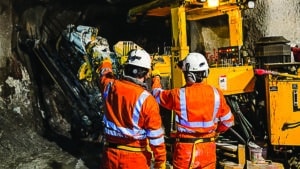Compressed air leaks can wreak havoc on a mine site. Luckily FLIR, a Teledyne Technologies company, has a solution.
Air compressors are widely used in the mining industry, especially in the underground sector.
Underground mining employs a range of drilling methods, and this drilling is heavily reliant on compressed air systems to flush debris and cuttings.
Air compressor systems also have a large part to play in blasting, producing high-velocity streams that trigger explosives safely.
In fact, they have become such a staple in the mining industry that they can be found in almost every corner of a site.
But while compressed air has made mining safer and more efficient, it is not without its challenges.
These systems can be prone to leaks, which can drive up a mine’s energy costs due to wasted air – a compressed air system can lose 25–30 per cent of their air to leaks.
It’s in response to this situation that FLIR Systems engineered its acoustic imaging cameras.
“To meet the mining industry’s challenges, companies can turn to technology with a particular emphasis on condition-monitoring,” FLIR said.
“The FLIR Si124 acoustic imaging camera offers a powerful solution for condition-monitoring and is specifically designed to discover compressed air leaks and partial discharges, as well as bearing issues and detection of some gases.”
The FLIR Si124 detects ultrasonic frequencies of a compressed air system leak through its 124 low-noise MEMS microphones.
And with the complimentary FLIR acoustic camera viewer, images of the problem can be visualised quickly and uploaded for immediate analysis.
“This service provides users with valuable insights, such as the energy costs of compressed air leaks and the classification, severity assessment, and recommended corrective actions,” FLIR said.
“The camera requires minimal training and is easy to incorporate into the maintenance cycle of a mining operation, even in the noisiest of environments.”

Image: Peruphotart/shutterstock.com
The FLIR Si124 is known for its one-handed ease-of-use operation, and the acoustic imaging camera enables operators to complete inspections up to 10 times faster than traditional methods.
“By employing acoustic imaging cameras to promptly detect and address leaks, mining operations can enhance their energy efficiency and decrease overall energy consumption,” FLIR said.
This leads to reduced operational expenses and an improved environmental footprint, helping to enhance a mine’s safety.
“The 124 sensitive microphones are advantageous also for high-voltage systems and substations, enabling operators to maintain a safe distance when inspecting energised equipment,” FLIR said.
“The non-contact camera works from an operational distance of between 0.3m and 130m, allowing condition-based maintenance to occur in large areas safely and efficiently, and without halting operation.
“As a result, mines can promptly mitigate safety risks while optimising the performance of their equipment.”
Compressed air leaks can translate to a costly problem for a mine site, so getting on top of them is essential.
“Leaks in the compressed air system can be detrimental to the mining process, increasing energy costs, reducing tool efficiency, and increasing maintenance requirements,” FLIR said.
“The FLIR Si124 acoustic imaging camera offers a powerful solution for condition-monitoring in mining facilities, detecting compressed air leaks early and improving operational continuity.”
This feature appeared in the April 2024 issue of Australian Mining.




